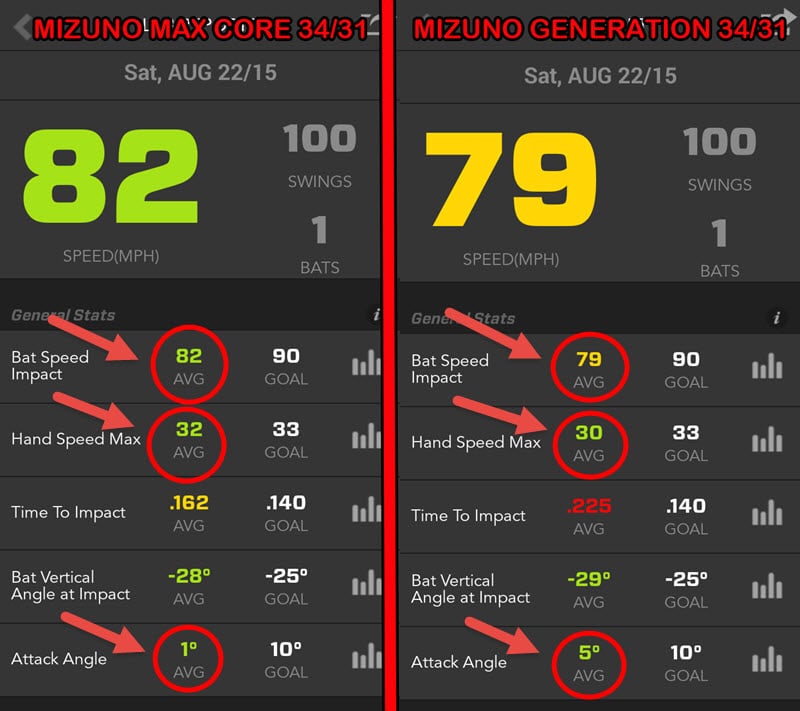Best BBCOR Or USSSA Baseball Bats For Power & Contact Hitters 2022 2023? | Does Under $200 Perform Better? | Fastpitch & Slowpitch Softball? End-Loaded Drop 3 Versus Drop 10?
Discover the best BBCOR or USSSA baseball bats for power and contact hitters in 2022 or 2023 based on price. Learn whether an under $200 bat outperforms it’s more expensive counterpart in this swing experiment. For fastpitch and slowpitch softball, it’s crucial to discern this fact. What about end-loaded BBCOR drop 3 versus USSSA drop 10?
Question: Do More Expensive Bats Increase Bat & Ball Exit Speeds?
In this baseball batting practice Mizuno bat model experiment using the Zepp (Labs) Baseball app & Bushnell radar gun
, I wanted to use the Scientific Method to analyze what would happen to Bat and Ball Exit Speeds comparing the performance of two different Mizuno bat models, but the same 34-inch, 31-ounce size:
- Mizuno MaxCor
($150-400 on Amazon), and
- Mizuno Generation
($70-200 on Amazon).
Background Research
MIZUNO MAXCOR ($150-400)
According to the Mizuno website, the focus of this bat is maximizing Ball Exit Speed and backspin. Some key features are (Mizuno site):
- Viscoelastic Sleeve: Creates a wider circumferential sweet area.
- New Variable Wall Thickness Alloy Core: Increases the sweet area across the length of the barrel, using aircraft aluminum alloy used to keep overall weight low.
- Dynamic Damper: Transition piece from barrel to handle absorbs vibration for better feel.
- New Improved Synthetic Leather Grip: Provides tack and great feel.
- Lower more balanced swing weight for increased swing speed.
- BBCOR certified, approved for NCAA & NFHS play
- Barrel Diameter: 2 5/8″
SCIENCE-BASED TRAINING:
Improve your hitting strategy dramatically by applying human movement principles.
Learn not only how and what to train but also the science behind the methods.
MIZUNO GENERATION
According to Mizuno’s site, the Mizuno Generation baseball bat was designed with two things in mind:
- A bigger sweet spot, and
- Balance – (lighter swing weight, which can result in faster bat speeds).
Key features of the baseball batting practice Mizuno Generation bat (Mizuno site):
- Patented wall thickness technology varies the wall thickness across the barrel, creating a massive sweet area for ultimate forgiveness
- Single wall aerospace grade aluminum alloy used for maximum combination of performance and durability
- Balanced swing weight for increased swing speed and bat control
- Digi-Grip for great feel and durability
- BBCOR certified, approved for USSSA
- Barrel Diameter: 2 5/8″
Another factor in this baseball batting practice Mizuno bat model experiment will be breaking in a non-wood bat. CLICK HERE for a good YouTube video on how to break-in a composite bat. Now, both Mizuno bats are not composites, but I’m sure the breaking in process with any alloy, will have an affect on Ball Exit Speeds.
We’ll adjust the data to address breaking in the bat in the Notes section.
Hypothesis
Based on the above baseball batting practice Background Research from Mizuno (albeit promotional materials), and the fact the MaxCor is double the price, I’d expect a much better performance in Bat and Ball Exit Speeds using the MaxCor model bat versus the Generation.
Baseball Batting Practice: Mizuno Bat Model Experiment
Equipment Used:
- Zepp Baseball app
,
- Bushnell radar gun
,
- ATEC Single Tuffy Tee
,
- Flip Camera
,
- 34/31 Mizuno Generation BBCOR bat, and
- 34/31 Mizuno MaxCore BBCOR bat.
Setup:
- All baseball batting practice swings were taken off the tee.
- I used two yellow dimple ball markers to make my stance setup consistent…one was placed inside my back foot, close to the plate. The other was placed one bat’s length plus two baseballs in front of the back marker.
- CLICK HERE for the Google Drive excel document with all the Ball Exit Speed (BES) readings.
- We deleted radar gun mis-reads that registered below 30-mph on the gun.
- Therefore, we deleted 11 mis-reads from the Mizuno MaxCor bat data, and averaged all MaxCor BES readings to 89 swings.
- Also, we deleted 7 mis-reads from the Mizuno Generation bat data, and averaged all Generation BES readings to 93 swings.
- The two tests in the experiment were counter-balanced. Which consisted of eight blocks of 25-swings done in the following order ABBA BAAB. Swinging the “Mizuno MaxCor” were letter ‘A’, and
“Mizuno Generation” were letter ‘B’. 200 total swings were completed in the experiment, 100 per test. Counter-balancing helps remove the “getting tired” and “not being warmed” up factors.
Data Collected (Zepp Baseball App):
Data Analysis & Conclusion
ZEPP READINGS:
- Avg. Bat Speed at Impact increased by 3-mph using the Mizuno MaxCor,
- Avg. Max Hand Speed increased by 2-mph using the Mizuno MaxCor,
- Avg. Time to Impact decreased by 0.063,
- Avg. Bat Vertical Angle at Impact decreased by 1-degree using the Mizuno MaxCor, and
- Avg. Attack Angle decreased by 4-degrees using the Mizuno MaxCor.
BUSHNELL BALL EXIT SPEED READINGS (CLICK HERE for Google Excel Doc):
- Avg. Ball Exit Speed increased by 4.6-mph using the Mizuno Generation bat,
- Top out Ball Exit Speed was 95-mph using the Mizuno Generation bat, and
- Top out Ball Exit Speed was 90-mph using the Mizuno MaxCor bat.
Notes
- Now, we can’t compare apples to apples baseball batting practice data using the Zepp app and Bushnell radar gun. If I had one more Bushnell radar gun capturing my bat speed readings perpendicular to my chest, then that would’ve been an interesting comparison.
- I felt much more balance with the Mizuno Generation. I also felt like I was more consistently hitting the sweet spot, as their marketing suggests. For some reason it was tough feeling a consistent sweet spot using the MaxCor, maybe because of the “Dynamic Damper: Transition piece from barrel to handle absorbs vibration for better feel”.
- It takes about 100-200 swings to break in a non-wood bat, at least according to the following YouTube video on How-To Break-in a Composite Bat. I’m going to share a Zepp app screenshot comparing the first 100 swings using the Mizuno MaxCor (from this experiment), to the first 100 swings using the Mizuno Generation (from the Baseball Swing Tips: Mizuno Bat Size Experiment):

Look at the near identical performance Zepp data between the two bats when we compare their first 100 swings…
- How about comparing the Ball Exit Speeds of the first 100 swings…according to this Google spreadsheet, the Mizuno MaxCor Avg. Ball Exit Speed was: 83.5-mph. And according to this Google spreadsheet from a couple weeks before, Avg. Ball Exit Speed using the Mizuno Generation 34/31 was: 88.3-mph.
The Bottom Line?
Well, according to the baseball batting practice Mizuno bat model experiment data, it looks like the Generation model holds the performance edge when it comes to Ball Exit Speed, almost a 5-mph difference. That’s about 20-feet of extra distance! From how the experiment turned out, I’d save the $200 and buy a Mizuno Generation. Now, this data doesn’t mean EVERY expensive bat will under-perform it’s more economic brethren, it just means you need to tinker and test to find the truth.
- Fix Late Swings Fast: 2025 Pitch Recognition & See-Decide-Swing Training for Youth Baseball Power Hitters - October 6, 2025
- Safe Youth Weighted Bat Training: Proven Overload/Underload Drills to Increase Exit Velocity in Games Starting Tonight - September 29, 2025
- AI Coaching Course 2025: Youth Baseball & Softball Practice Plan + Off-Season & In-Season Workout Builder Fast - September 23, 2025






Great info!! Keep up the good work Joey!
Thanks Colby! Will do 🙂
You said ( The maxcore was greater in all areas but attack angle) … I think attack angle is the sum of all parts of your swing and is generated by you and not the bat. As attack angle gets lower hand speed and bat speed tend to be higher. This is because the bat is shorter to the baseball and has not started its upward ascent. Aka you swung more level and a level swing will yield greater speed results than a swing with a lifted attack angle. Attack angle is generated by not swinging up but where the ball is struck in relationship to your front foot, where the tee is placed, and if your barrel stays above your hands in relationship to vertical angle of the swing.
The higher exit speed results could be off due to the much slower time to impact. Time to impact is just the relationship between the bat first moves forward and when it hits the ball. So if you were getting a greater load usually the time to impact will show slower. Aka the bat moved forward not with your hands but with your body..the zepp doesn’t know the difference between the start of a swing and someone moving there body towards the ball..or scap loading
Of course I’m a dork and way to into hitting and I realize I could be wrong period.
Jeremy, I appreciate your analysis, and it is quite insightful…giving me some different things to think about. Thank YOU. However, this experiment was compromised because of the different MOI’s of the bats. I didn’t take that into account. Ideally, for the experiment to work, both bats had to be the same size and weight, and the same balance (MOI). What was interesting though, that you forgot to mention was the almost 5-mph increase in Ball Exit Speed using the Mizuno Gen bat, and the top out bat speed difference. All that being said, I would have to do this experiment over using the same MOI bats.
Does this experiment have the same results with slow pitch bats if not have you done it with them I’d love to see the results when choosing my next bat.
Great questions Demetrius. Here’s what I’ve found in my experiments and research when it comes to bats, regardless of whether they’re baseball, fast-pitch softball, or slow pitch softball…
*All things being equal, end loaded bats produce more ball exit speed.
*All things being equal, one piece bats produce more ball exit speed.
*All things being equal, more expensive bats don’t always mean more ball exit speed.
*As for which size bat is right, there’s opportunity there to test different sizes per hitter to optimize production numbers. In other words, just because a 33/30 works for one player, doesn’t mean it’ll be the right size for another.
I hope this helps.